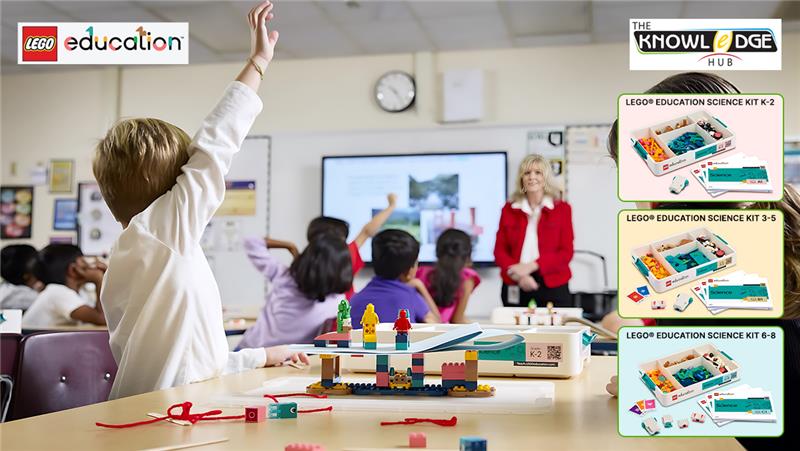
10 Hands-On Ways to Boost Kids’ Science Skills
(Read time: 4 minutes)
As a pioneer in the Ed-tech field in the UAE & GCC, Knowledge Hub helps schools, teachers, and families turn curiosity into real understanding. In this guide, you’ll find practical, classroom-tested ideas to build science skills—plus where LEGO® Education science kits fit for K–8 learners (and how to get them in Dubai or across the GCC).
1. Start with a phenomenon (not a definition)
Open with a puzzling demo—rolling objects, melting ice, a shadow that “moves.” Ask: What do you notice? What do you wonder?
Why it works: This approach kicks off inquiry-based learning and boosts engagement from the very first moment.
Try with kits: Use the LEGO® Education Science Kit K–2 to compare surfaces and how bricks slide or stop. Students observe friction in action before you ever mention the word “friction.”
2. Build first, name later
Before teaching “force” or “friction,” let students build a simple model and test. Then introduce vocabulary when they’ve already experienced the concept firsthand.
Try with kits: The LEGO® Education Science Kit 3–5 with double motor lets students explore pushes, pulls, and speed through hands-on experimentation before formal instruction.
3. Make predictions visible
Have learners sketch or video their predictions. After testing, compare evidence versus expectation. This builds critical thinking and meta-cognitive skills.
Teacher tip: Short prediction slips increase student engagement and reflection. Keep them simple— one sentence or a quick drawing is enough.
4. Engineer a better version
Every build is a prototype. Ask students to iterate: make it lighter or heavier, longer or shorter, try different gears. This mirrors real-world engineering design cycles.
Try with kits: The LEGO® Education Science Kit 6–8 is perfect for testing variables and analyzing results through multiple iterations.
5. Bring in measurement (early and often)
Swap “cool experiment” for “measured investigation.” Timers, rulers, counts, and charts convert fun into teaching science concepts with rigor and precision.
Extension idea: Graph results together and discuss anomalies. Why did this trial differ? What does that tell us about our model?
6. Use talk moves
Encourage structured discourse: “I agree with because…,” “I’d like to add…,” “I have a different idea…”
Why it works: This builds reasoning skills, not just right answers. Students learn to justify their thinking and engage with peers’ ideas respectfully.
7. Connect to real-world systems
Energy use, recycling, weather, traffic—science is everywhere. Design challenges that solve local problems relevant to Dubai and the GCC: extreme heat management, coastal winds, campus recycling, water conservation.
Try with kits: Model windmills or vehicles and discuss energy transfer in the context of renewable energy solutions for the region.
8. Mix modalities: build + draw + write
A quick diagram or caption consolidates learning. Different students process information differently— combining visual, kinesthetic, and written work reaches everyone.
Homeschool tip: Have learners present a one-minute show-and-tell of their model. This builds presentation skills and confidence
9. Showcase learning publicly
End each cycle with a mini-expo, a hallway gallery, or a short video reel. When students know their work will be seen, their language and confidence soar.
Good for: Improving student engagement in science and building a culture of excellence and pride in your classroom or school.
10. Keep the teacher’s load light
Choose tools with ready-to-teach lessons, student slides, and facilitation notes so you can focus on coaching—not hunting for materials or creating curriculum from scratch.
Solution: LEGO® Education’s Teacher Portal provides standards-aligned lessons, getting-started materials, and ongoing support for educators.
Which LEGO® Education science kit fits my learners?
LEGO® Education Science Kit K2
Great for: Observing patterns, simple pushes/pulls, and cause-effect relationships
Hands-on science activities include:
- Ramps & rollers experiments
- Shadow makers to explore light
- Mini-habitats for life science observation
- Simple machines introductions
LEGO® Education Science Kit 3-5
Includes: 278+ bricks, a double motor, and USB charging
Perfect for: Testing variables (mass, distance, speed) and conducting fair tests
Key activities:
- Energy transfer with gears and wheels
- Data collection and analysis
- Fair test design and execution
- Force and motion investigations
LEGO® Education Science Kit 6-8
Best for: Design-thinking challenges, multi-step investigations, and data-driven iterations
Advanced activities:
- Compound machines design challenges
- Engineering design cycles
- Evidence-based claims and argumentation
- Complex systems modeling
Looking for LEGO education in Dubai or across the GCC? Knowledge Hub supports schools and homeschoolers with onboarding, training, and classroom implementation—so your kits translate into meaningful learning from day one.
Frequently Asked Questions
Q1. Where can I buy LEGO education sets in Dubai?
From Knowledge Hub—we support schools across the UAE & GCC with expert selection guidance, comprehensive on-boarding, and ongoing training. Our team ensures you’re not just purchasing kits, but implementing a complete educational solution.
Q2. What teacher support is included?
The LEGO® Education Teacher Portal offers ready-to-teach lesson plans, student materials, and facilitation notes.
Q3. How do these kits improve student engagement in science?
By combining hands-on science activities with inquiry-based learning—students build, test, and iterate, which naturally increases curiosity, discussion, and active participation. Research shows that kinesthetic learning significantly boosts retention and enthusiasm.
Q4. Do I need coding knowledge to use these kits?
No. The focus is inquiry-based science. Some builds include motion/energy elements, but teachers don’t need coding to get started.
Q5. Is this suitable for homeschooling?
Yes. Clear step-by-step builds and short investigations make it easy for families; you can run 1–2 learners per kit.





Recent Comments